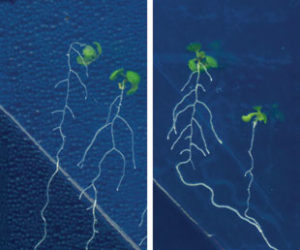DP Petrella, EH Han, EJ Nangle, JC Scheerens… – … and Experimental Botany, 2018
Abstract
Halotropism is a form of adaptive directional growth in which roots grow away from areas of high salt concentrations. Halotropism is thought to function in cooperation with the more well-understood mechanisms of ion exclusion and sequestration to mediate salt tolerance. Halotropic growth is dependent upon precisely regulated changes in auxin transport and metabolism. As both of these processes have been demonstrated to be modulated by flavonoid accumulation, it is likely that flavonoids serve a regulatory role in halotropism. The objectives of this study were first to determine if the flavonoid hyper-accumulating turfgrass species rough bluegrass (Poa trivialis L.) exhibits halotropism, and, second, to investigate the impact of light-induced flavonoid accumulations on root halotropic bending responses. Results showed that rough bluegrass grown in an agar system under white light exhibits halotropic root growth when treated with salt gradients created by concentrations of NaCl greater than 300 mM. In the dark or with red light treatment, rough bluegrass did not exhibit halotropism, but when treated with blue light, halotropic growth was enhanced compared to white light treatment. Metabolomic analysis showed that flavonoids only accumulated in roots at levels above the limit of detection when plants were exposed to blue or white light. Altogether, results showed that rough bluegrass exhibits halotropism that correlates with light-induced accumulations of flavonoids.

… LED array spectral distribution was measured using a Stellarnet ® BLACK- Comet spectroradiometer, and a Stellarnet ® CR2 cosine receptor; spectra were analyzed using SpectraWiz ® software (Stellarnet ® Inc., Tampa, FL, USA) …





